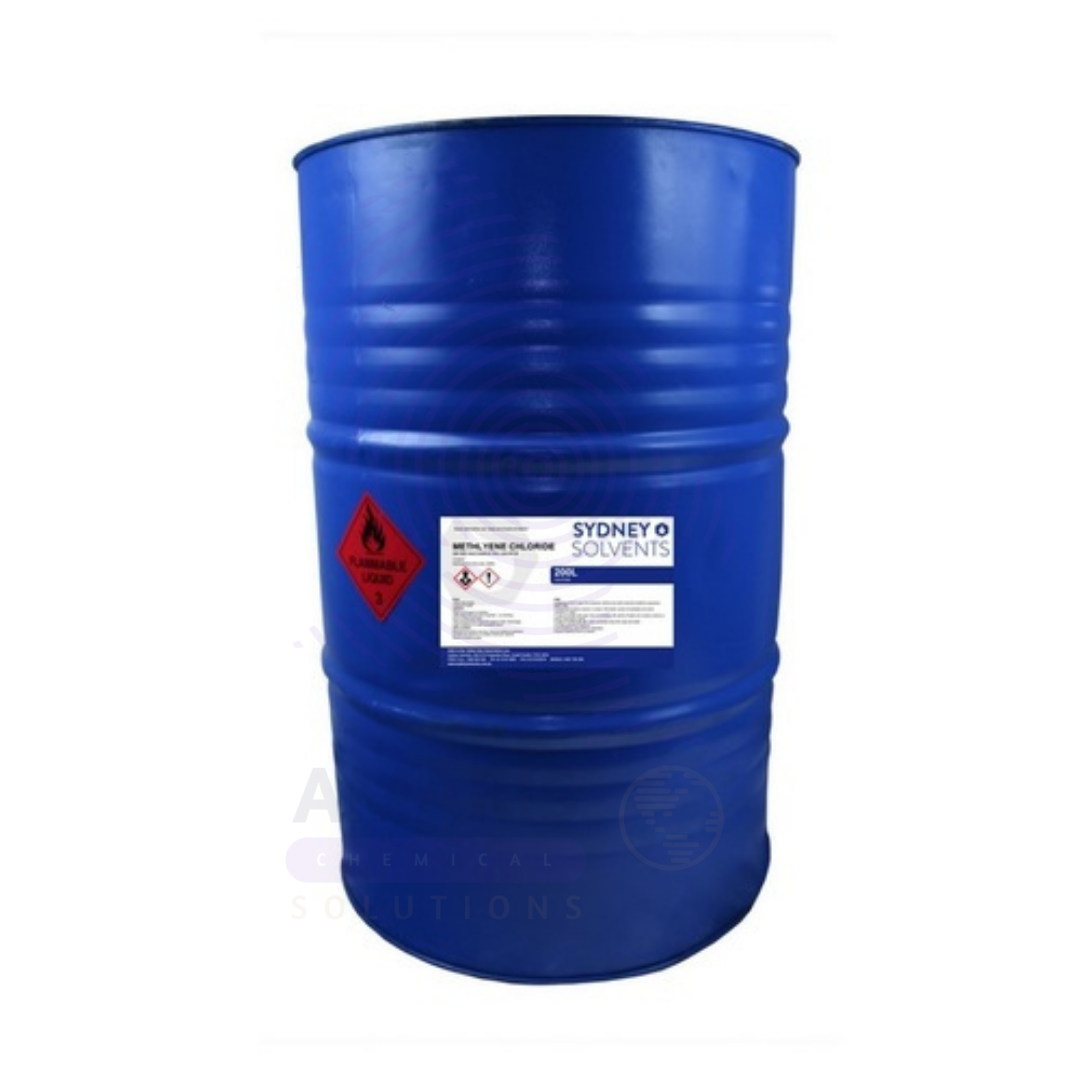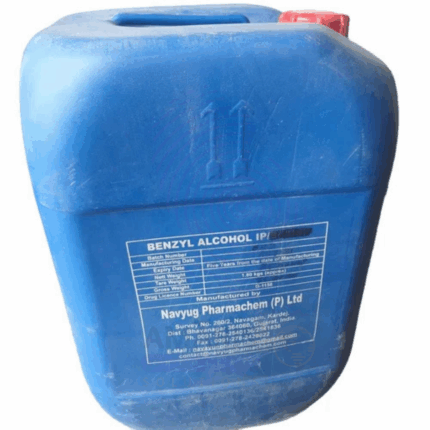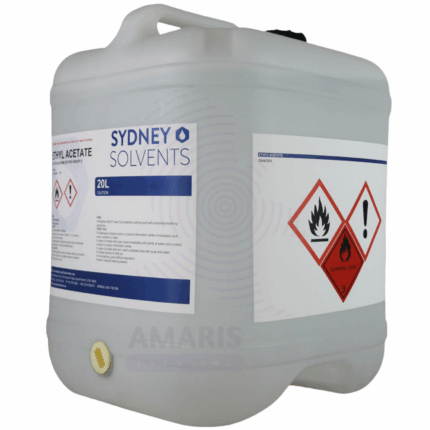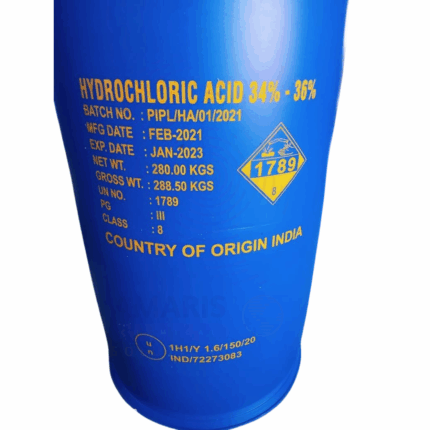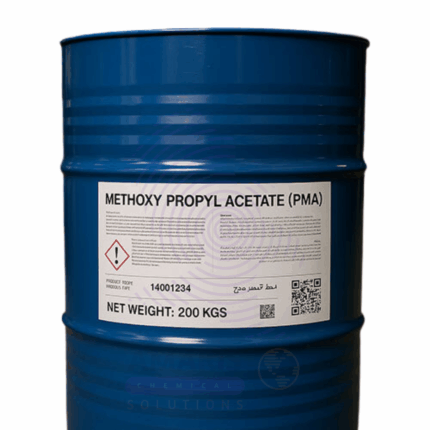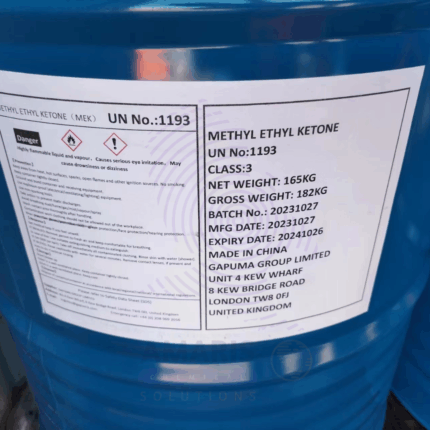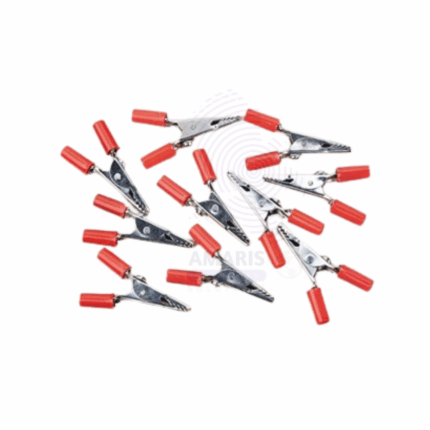
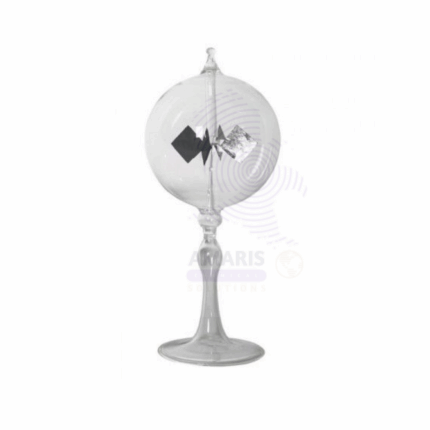
Dichloromethane
$ 3.00 Original price was: $ 3.00.$ 2.90Current price is: $ 2.90.
Dichloromethane, also known as methylene chloride, is a volatile, colorless liquid with a sweet, chloroform-like odor. It is a chlorinated solvent widely used in industrial, pharmaceutical, and laboratory applications due to its excellent solvent properties, including high volatility, moderate polarity, and low boiling point (about 39.6°C). DCM is prized for its ability to dissolve a wide range of organic compounds, making it ideal for extraction, paint stripping, degreasing, and chemical processing. However, due to health and environmental concerns, its use is regulated and controlled in many countries.
Dichloromethane
Primary Uses
Solvent in Chemical Industry
- Extraction Solvent: Utilized in pharmaceutical, food, and chemical industries for extraction processes due to its ability to selectively dissolve organic substances.
- Paint and Coating Remover: Effective in removing paints, varnishes, and coatings from surfaces.
- Degreasing Agent: Employed to clean metal parts and machinery by dissolving greases and oils.
- Adhesive Formulations: Used in adhesives and glue formulations to adjust viscosity and improve application.
Pharmaceutical Manufacturing
- Solvent for API Synthesis: Utilized in drug manufacturing as a reaction medium or solvent for active pharmaceutical ingredients (APIs).
- Purification Processes: Employed in purification and crystallization of drugs.
- Laboratory and Analytical Uses
- Chromatography: Used as a solvent in chromatographic techniques including gas chromatography and liquid chromatography.
- Sample Preparation: Common solvent for dissolving and preparing samples for analysis.
- Foam and Aerosol Industry
- Foam Blowing Agent: Used as a blowing agent for polyurethane foams.
- Aerosol Propellant: Historically used as propellant in aerosols (now largely phased out due to regulations).
Secondary Uses
Food Industry
- Decaffeination of Coffee and Tea: Historically used in the decaffeination process (restricted now due to safety concerns).
Electronics Industry
- Cleaning Agent: Used for cleaning circuit boards and electronic components because of its non-conductive properties and solvent power.
Metalworking Industry
- Machining Coolant Additive: Sometimes incorporated into metalworking fluids for enhanced cleaning and degreasing.
Polymer Processing
- Used as a solvent in the production and processing of polymers and resins.
- Basic Identification Attributes
- Chemical Name (IUPAC): Dichloromethane
- Common/Trade Name: Methylene Chloride, DCM
- CAS Number: 75-09-2
- HS Code: 2903.39.00
- Molecular Formula: CH₂Cl₂
- Synonyms:
- Methylene chloride
- DCM
- Methane, dichloro-
- Physical & Chemical Properties
- Physical State: Colorless liquid
- Odor: Sweet, chloroform-like
- Boiling Point: 39.6°C
- Melting Point: −95°C
- Density: 1.33 g/cm³ at 20°C
- Vapor Pressure: High (about 47.3 kPa at 20°C)
- Solubility: Slightly soluble in water (13 g/L at 20°C); miscible with organic solvents
- Flash Point: None (non-flammable under normal conditions)
- Safety & Hazard Attributes
- Hazard Class (GHS): Acute toxicity (oral, inhalation), carcinogenicity category 2, central nervous system depressant
- Toxicity: Harmful if inhaled or ingested; suspected carcinogen; may cause dizziness, nausea, and CNS depression
- Exposure Limits: OSHA PEL – 25 ppm (8 hr TWA); NIOSH REL – 25 ppm
- Flammability: Non-flammable, but can form explosive mixtures under certain conditions
- Storage & Handling Attributes
- Storage Conditions: Store in a cool, well-ventilated area, away from heat, ignition sources, and incompatible materials
- Container Type: Metal or glass containers with tight seals
- Shelf Life: Stable if stored properly
- Handling Precautions: Use in well-ventilated areas or fume hoods; wear appropriate PPE
- Regulatory & Compliance Attributes
- Regulatory Status: Subject to strict regulations due to toxicity and environmental impact (e.g., EPA, REACH, OSHA)
- Transportation: Classified as hazardous for transport; follow DOT and IMDG regulations
- Environmental Compliance: Monitored due to potential groundwater contamination and air pollution
- Environmental & Health Impact
- Biodegradability: Not readily biodegradable; persists in the environment
- Ecotoxicity: Toxic to aquatic organisms; avoid release to waterways
- Bioaccumulation: Low potential
Carcinogenicity/Mutagenicity: Classified as possibly carcinogenic to humans (IARC Group 2B)
Safety Handling Precautions
- PPE Required:
- Respirator with organic vapor cartridge or supplied air
- Chemical-resistant gloves
- Safety goggles or face shield
- Lab coat or protective clothing
- Handling Guidelines:
- Use in well-ventilated or exhaust-equipped areas
- Avoid inhalation of vapors and skin contact
- Avoid prolonged exposure and accumulation in confined spaces
- Storage Measures:
- Keep containers tightly closed
- Store away from strong oxidizers, alkali metals, and reducing agents
First Aid Measures
- Inhalation: Move person to fresh air; provide oxygen if breathing is difficult; seek immediate medical attention
- Skin Contact: Wash affected area with plenty of soap and water; remove contaminated clothing; seek medical advice if irritation persists
- Eye Contact: Rinse eyes with water for at least 15 minutes; get medical attention
- Ingestion: Do not induce vomiting; rinse mouth; seek urgent medical attention
Firefighting Measures
- Fire Hazards: Non-flammable but may decompose under fire producing toxic gases
- Extinguishing Media: Use water spray, foam, dry chemical, or CO₂
- Special Precautions: Wear full protective gear and SCBA; avoid inhaling fumes
Decomposition Products: Hydrogen chloride, phosgene, carbon monoxide, carbon dioxide


 Preservatives(food)
Preservatives(food) Flavor Enhancers
Flavor Enhancers Acidulants
Acidulants Sweeteners
Sweeteners Antioxidants
Antioxidants Colorants(food)
Colorants(food) Nutraceutical Ingredients (food)
Nutraceutical Ingredients (food) Nutrient Supplements
Nutrient Supplements Emulsifiers
Emulsifiers
 Collectors
Collectors Dust Suppressants
Dust Suppressants Explosives and Blasting Agents
Explosives and Blasting Agents Flocculants and Coagulants
Flocculants and Coagulants Frothers
Frothers Leaching Agents
Leaching Agents pH Modifiers
pH Modifiers Precious Metal Extraction Agents
Precious Metal Extraction Agents
 Antioxidants(plastic)
Antioxidants(plastic) Colorants (Pigments, Dyes)
Colorants (Pigments, Dyes) Fillers and Reinforcements
Fillers and Reinforcements Flame Retardants
Flame Retardants Monomers
Monomers Plasticizers
Plasticizers Polymerization Initiators
Polymerization Initiators Stabilizers (UV, Heat)
Stabilizers (UV, Heat)
 Antifoaming Agents
Antifoaming Agents Chelating Agents
Chelating Agents Coagulants and Flocculants
Coagulants and Flocculants Corrosion Inhibitors
Corrosion Inhibitors Disinfectants and Biocides
Disinfectants and Biocides Oxidizing Agents
Oxidizing Agents pH Adjusters
pH Adjusters Scale Inhibitors( water)
Scale Inhibitors( water)
 Antioxidants(cosmetic)
Antioxidants(cosmetic) Emollients
Emollients Fragrances and Essential Oils
Fragrances and Essential Oils Humectants
Humectants Preservatives
Preservatives Surfactants(cosmetic)
Surfactants(cosmetic) Thickeners
Thickeners UV Filters
UV Filters
 Fertilizers
Fertilizers Soil Conditioners
Soil Conditioners Plant Growth Regulators
Plant Growth Regulators Animal Feed Additives
Animal Feed Additives Biostimulants
Biostimulants Pesticides (Herbicides, Insecticides, Fungicides)
Pesticides (Herbicides, Insecticides, Fungicides)
 Active Pharmaceutical Ingredients (APIs)
Active Pharmaceutical Ingredients (APIs) Excipients
Excipients Solvents(pharmaceutical)
Solvents(pharmaceutical) Antibiotics
Antibiotics Antiseptics and Disinfectants
Antiseptics and Disinfectants Vaccine Adjuvants
Vaccine Adjuvants Nutraceutical Ingredients (pharmaceutical)
Nutraceutical Ingredients (pharmaceutical) Analgesics & Antipyretics
Analgesics & Antipyretics
 Analytical Reagents
Analytical Reagents Solvents(lab)
Solvents(lab) Chromatography Chemicals
Chromatography Chemicals Spectroscopy Reagents
Spectroscopy Reagents microbiology-and-cell-culture-reagents
microbiology-and-cell-culture-reagents Molecular Biology Reagents
Molecular Biology Reagents Biochemical Reagents
Biochemical Reagents Inorganic and Organic Standards
Inorganic and Organic Standards Laboratory Safety Chemicals
Laboratory Safety Chemicals Specialty Laboratory Chemicals(Special Laboratory Equipment)
Specialty Laboratory Chemicals(Special Laboratory Equipment)
 Demulsifiers
Demulsifiers Hydraulic Fracturing Fluids
Hydraulic Fracturing Fluids Scale Inhibitors(oil)
Scale Inhibitors(oil) Surfactants(oil)
Surfactants(oil) Drilling Fluids
Drilling Fluids
 Dyes and Pigments
Dyes and Pigments Bleaching Agents
Bleaching Agents Softening Agents
Softening Agents Finishing Agents
Finishing Agents Antistatic Agents
Antistatic Agents
 Admixtures
Admixtures Waterproofing Agents
Waterproofing Agents Sealants and Adhesives
Sealants and Adhesives Curing Compounds
Curing Compounds Concrete Repair Chemicals
Concrete Repair Chemicals Anti-Corrosion Coatings
Anti-Corrosion Coatings
 Surfactants(cleaning)
Surfactants(cleaning) Builders
Builders Enzymes
Enzymes Solvents (Cleaning)
Solvents (Cleaning) Fragrances
Fragrances
 Electronic Chemicals
Electronic Chemicals Catalysts
Catalysts Lubricants
Lubricants Photographic Chemicals
Photographic Chemicals Refrigerants
Refrigerants Automotive chemicals
Automotive chemicals Pyrotechnic Chemicals
Pyrotechnic Chemicals
 Biodegradable Surfactants
Biodegradable Surfactants Bio-based Solvents
Bio-based Solvents Renewable Polymers
Renewable Polymers Carbon Capture Chemicals
Carbon Capture Chemicals Wastewater Treatment Chemicals
Wastewater Treatment Chemicals
 Pigments
Pigments Solvents(paint)
Solvents(paint) Specialty Coatings
Specialty Coatings Binders/Resins
Binders/Resins Additives
Additives Driers
Driers Anti-Corrosion Agents
Anti-Corrosion Agents Functional Coatings
Functional Coatings Application-Specific Coatings
Application-Specific Coatings
 Fresh Herbs
Fresh Herbs Ground Spices
Ground Spices Whole Spices
Whole Spices Spice Blends
Spice Blends Dried Herbs
Dried Herbs
 Leavening Agents
Leavening Agents Dough Conditioners
Dough Conditioners Flour Treatments
Flour Treatments Fat Replacers
Fat Replacers Decoratives
Decoratives Preservatives(baking)
Preservatives(baking)
 Plasticizers & Softeners
Plasticizers & Softeners Reinforcing Agents
Reinforcing Agents Adhesion Promoters
Adhesion Promoters Vulcanizing Agents
Vulcanizing Agents Antidegradants
Antidegradants Blowing Agents
Blowing Agents Fillers & Extenders
Fillers & Extenders Accelerators & Retarders
Accelerators & Retarders